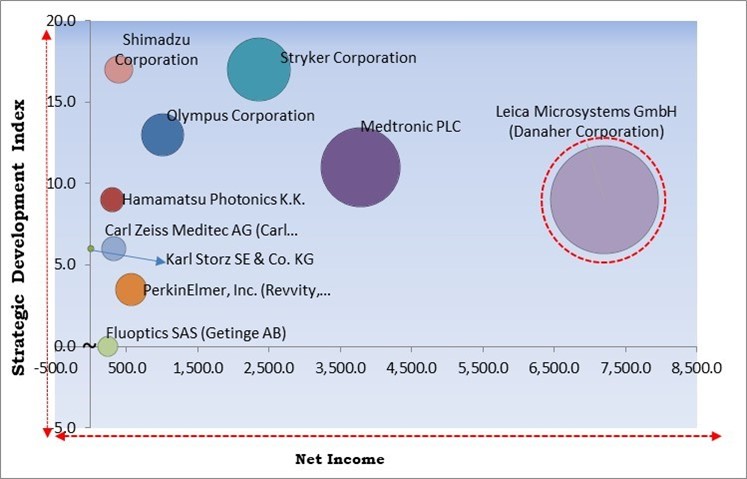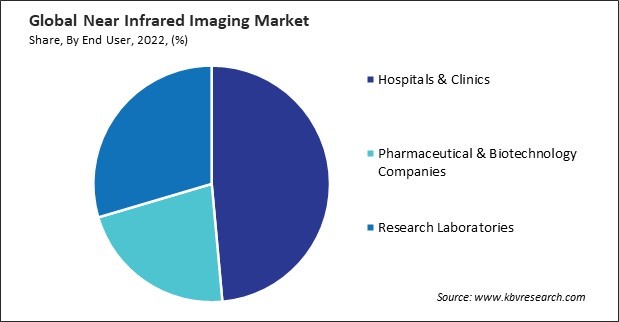
The Global Near Infrared Imaging Market size is expected to reach $3.2 billion by 2030, rising at a market growth of 6.0% CAGR during the forecast period.
NIR imaging reagents are used in various industrial applications, such as quality control in manufacturing processes, food safety testing, and material characterization. Therefore, the reagents segment captured $1,204.2 million revenue in the market in 2022. Moreover, the increasing use of NIR imaging in medical diagnostics and research has driven the demand for NIR imaging reagents. These reagents play a crucial role in enhancing the sensitivity and specificity of NIR imaging techniques, particularly in applications such as fluorescence imaging and molecular imaging.

The major strategies followed by the market participants are Product launches as the key developmental strategy to keep pace with the changing demands of end users. For instance, In August, 2022, Shimadzu introduced the LuminousQuester NI near-infrared imaging system, which comprises dedicated software and a camera that is capable of concurrently imaging visible light and near-infrared light. The system records near-infrared light that is less interfered with indoor lighting and because of this imaging can be carried out in a vast range of testing environments. Additionally, In November, 2023, Olympus Corporation had announced the release of its next-generation EVIS X1™ endoscopy system in China, completing its availability in all major markets. The EVIS X1 is Olympus' most advanced endoscopy system. Olympus® GI endoscopy systems, including the EVIS X1, assisted physicians in diagnosing.
Based on the Analysis presented in the KBV Cardinal matrix; Leica Microsystems GmbH (Danaher Corporation) is the major forerunner in the Near Infrared Imaging Market. In April, 2020, Leica Microsystems introduced STELLARIS, a flagship new confocal microscopy platform. STELLARIS enhanced the capability of capturing three-dimensional images of living cells and tissues. The platform added a dimension of information to confocal imaging and provided access to lifetime-based information in every experiment. Companies such as Medtronic PLC, Stryker Corporation and Olympus Corporation are some of the key innovators in the Near Infrared Imaging Market.

The pandemic led to disruptions in global supply chains, affecting the production and distribution of NIR imaging devices and components. This disruption resulted in delays in product availability and increased costs for manufacturers. Many research institutions and companies redirected their resources toward COVID-19-related research, leading to reduced investment in non-essential areas such as NIR imaging technology development. This shift in focus slowed down innovation and product development in the market. Therefore, while the COVID-19 pandemic presented challenges for the NIR imaging market, it also created opportunities, especially in the healthcare sector where there was increased demand for imaging technologies.
As the number of surgeries increases, there is a greater demand for imaging systems that can provide real-time, high-resolution imaging to aid surgeons in achieving greater precision during procedures. Moreover, the growing preference for minimally invasive surgical techniques, which require advanced imaging technologies for visualization, has led to an increased demand for NIR imaging systems. The frequency and incidence of a number of diseases, including cardiovascular diseases, cancer, neurovascular disorders, and gastrointestinal diseases, are on the rise, which is contributing to an increase in the number of surgical procedures performed. Additionally, some developing countries are becoming popular destinations for medical tourism due to lower costs and high-quality healthcare services. The demand for advanced imaging technologies like NIR systems is driven by the need to cater to the growing number of medical tourists seeking diagnostic and treatment services. Thus, the need for diverse imaging modalities, such as NIR imaging, has expanded in recent years as a direct result of the expansion of the life sciences research business, which will bolster the expansion of the market.
Stringent regulatory requirements for medical devices, including NIR imaging systems, can pose challenges for manufacturers, distributors, and healthcare providers. These hurdles may include lengthy approval processes, complex compliance standards, and high documentation requirements, all of which can delay the introduction of new products to the market. As a result, manufacturers may face increased costs and time-to-market for their NIR imaging systems, which can hinder innovation and limit the availability of advanced technologies for healthcare providers and patients. Furthermore, regulatory hurdles can impact the global competitiveness of NIR imaging technology. In regions with more relaxed regulatory environments, such as emerging markets, competing imaging technologies may gain a foothold more easily, potentially leading to disparities in access to advanced medical imaging technologies based on geographical location. Thus, all these challenges can create hurdles for manufacturers seeking to expand their market presence internationally and may limit the overall growth potential of the market.
 Drivers
Drivers  Restraints
Restraints On the basis of device type, the device segment of the market is segmented into near-infrared fluorescence imaging systems and near-infrared fluorescence & bioluminescence imaging systems. The near infrared fluorescence imaging systems segment recorded the largest revenue share in the market in 2022. The demand for NIR fluorescence imaging systems is driven by their ability to provide high-resolution, real-time imaging of tissues and structures, making them valuable tools in medical imaging, research, and clinical practice. The increase in the prevalence of gastrointestinal, cardiovascular, and cancer diseases are the main fields where these devices are widely employed. Additionally, the NIR fluorescence imaging systems help in the expedited discovery of functions associated with lymphatic systems. This is possible because of NIR's high sensitivity, which allows high temporal and spatial resolutions.
On the basis of application, the market is divided into preclinical imaging, cancer surgeries, gastrointestinal surgeries, cardiovascular surgeries, plastic/reconstructive surgeries, and other applications. The cardiovascular surgeries segment recorded a promising growth rate in the market in 2022. Cardiovascular diseases, including coronary artery disease, heart failure, and valvular heart disease, are among the leading causes of death worldwide. The high prevalence of these conditions drives the demand for cardiovascular surgeries as a treatment option to manage and treat these diseases. The aging population worldwide has led to an increase in the prevalence of age-related cardiovascular conditions, such as atherosclerosis and heart valve degeneration. As the population ages, there is a growing demand for cardiovascular surgeries to address these age-related conditions.
Based on end-user, the market is categorized into hospitals & clinics, pharmaceutical & biotechnology companies, and research laboratories. The hospitals and clinics segment witnessed the highest revenue share in the market in 2022. The demand for NIR imaging systems in hospitals and clinics is driven by their versatility, non-invasive nature, and ability to provide real-time insights into biological processes. Near-infrared sensors built into laparoscopic instruments assist surgeons to prevent unintentional blood vessel rupture. The use of these technologies aids in reducing surgical errors, shortening hospital stays, and lowering patient healthcare expenses.

Based on the product, the market is bifurcated into devices and reagents. The reagents segment dominated the revenue share in the near infrared imaging market in 2022. NIR imaging reagents are used in various industrial applications, such as quality control in manufacturing processes, food safety testing, and material characterization. Moreover, the increasing use of NIR imaging in medical diagnostics and research has driven the demand for NIR imaging reagents. These reagents play a crucial role in enhancing the sensitivity and specificity of NIR imaging techniques, particularly in applications such as fluorescence imaging and molecular imaging.
Based on the reagents type, the reagents segment is further fragmented into indocyanine green (ICG) and other reagents. The indocyanine green (ICG) segment witnessed the highest revenue share in the market in 2022. ICG is used in NIR imaging for vascular imaging and perfusion studies. It can be injected intravenously to assess blood flow dynamics, tissue perfusion, and vascular integrity in various medical specialties, including cardiology, neurology, and vascular surgery. In oncology, ICG is utilized for NIR imaging in cancer diagnosis and treatment. It can be conjugated with targeting moieties to specifically bind to cancer cells, allowing for the visualization of tumors and metastases. This application has driven the demand for ICG reagents in NIR imaging for cancer-related research and clinical use.
Free Valuable Insights: Global Near Infrared Imaging Market size to reach USD 3.2 Billion by 2030
On the basis of region, the near infrared imaging market is analyzed across North America, Europe, Asia Pacific, and LAMEA. The North America segment recorded the largest revenue share in the market in 2022. North America has a significant healthcare expenditure, with a focus on advanced medical technologies and innovative treatments. The increasing investment in healthcare infrastructure and research and development activities drives the demand for advanced imaging systems like NIR for diagnostic and therapeutic applications. Additionally, a rise in reconstructive and cosmetic procedures in the nation as a result of higher spending and growing awareness of early diagnosis is anticipated to generate significant growth potential.
| Report Attribute | Details |
|---|---|
| Market size value in 2022 | USD 2 Billion |
| Market size forecast in 2030 | USD 3.2 Billion |
| Base Year | 2022 |
| Historical Period | 2019 to 2021 |
| Forecast Period | 2023 to 2030 |
| Revenue Growth Rate | CAGR of 6% from 2023 to 2030 |
| Number of Pages | 362 |
| Number of Tables | 537 |
| Report coverage | Market Trends, Revenue Estimation and Forecast, Segmentation Analysis, Regional and Country Breakdown, Competitive Landscape, Porter’s 5 Forces Analysis, Company Profiling, Companies Strategic Developments, SWOT Analysis, Winning Imperatives |
| Segments covered | Product, Application, End User, Region |
| Country scope |
|
| Companies Included | Medtronic PLC, Stryker Corporation, Olympus Corporation, Hamamatsu Photonics K.K., Carl Zeiss Meditec AG (Carl Zeiss AG), PerkinElmer, Inc., Leica Microsystems GmbH (Danaher Corporation), Shimadzu Corporation, Karl Storz SE & Co. KG, Fluoptics SAS |
By Product
By Application
By End User
By Geography
This Market size is expected to reach $3.2 billion by 2030.
Growing number of surgeries globally are driving the Market in coming years, however, Lack of skilled NIR technology professionals restraints the growth of the Market.
Medtronic PLC, Stryker Corporation, Olympus Corporation, Hamamatsu Photonics K.K., Carl Zeiss Meditec AG (Carl Zeiss AG), PerkinElmer, Inc., Leica Microsystems GmbH (Danaher Corporation), Shimadzu Corporation, Karl Storz SE & Co. KG, Fluoptics SAS
The expected CAGR of this Market is 6.0% from 2023 to 2030.
The Preclinical Imaging segment is leading the Market by Application in 2022; thereby, achieving a market value of $1.1 billion by 2030.
The North America region dominated the Market by Region in 2022; thereby, achieving a market value of $1.2 billion by 2030.
Our team of dedicated experts can provide you with attractive expansion opportunities for your business.
